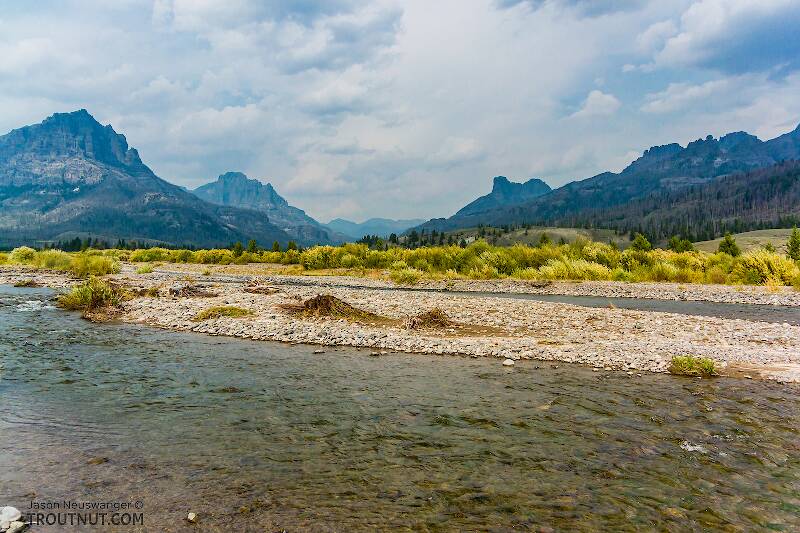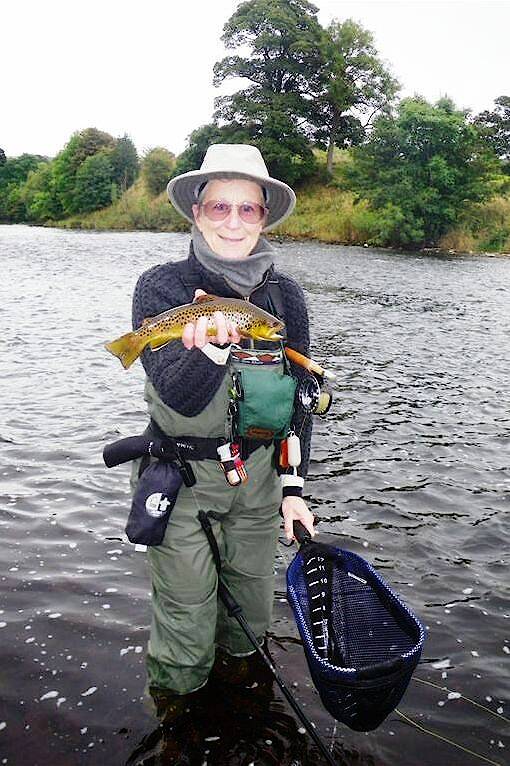
Hex Mayflies
Hexagenia limbata
The famous nocturnal Hex hatch of the Midwest (and a few other lucky locations) stirs to the surface mythically large brown trout that only touch streamers for the rest of the year.
Featured on the forum

It's only barely visible in one of my pictures, but I confirmed under the microscope that this one has a prosternal horn and the antennae are mid-way between the eyes and front of the head capsule.
I'm calling this one Pycnopsyche, but it's a bit perplexing. It seems to key definitively to at least Couplet 8 of the Key to Genera of Limnephilidae Larvae. That narrows it down to three genera, and the case seems wrong for the other two. The case looks right for Pycnopsyche, and it fits one of the key characteristics: "Abdominal sternum II without chloride epithelium and abdominal segment IX with only single seta on each side of dorsal sclerite." However, the characteristic "metanotal sa1 sclerites not fused, although often contiguous" does not seem to fit well. Those sclerites sure look fused to me, although I can make out a thin groove in the touching halves in the anterior half under the microscope. Perhaps this is a regional variation.
The only species of Pycnopsyche documented in Washington state is Pycnopsyche guttifera, and the colors and markings around the head of this specimen seem to match very well a specimen of that species from Massachusetts on Bugguide. So I am placing it in that species for now.
Whatever species this is, I photographed another specimen of seemingly the same species from the same spot a couple months later.
I'm calling this one Pycnopsyche, but it's a bit perplexing. It seems to key definitively to at least Couplet 8 of the Key to Genera of Limnephilidae Larvae. That narrows it down to three genera, and the case seems wrong for the other two. The case looks right for Pycnopsyche, and it fits one of the key characteristics: "Abdominal sternum II without chloride epithelium and abdominal segment IX with only single seta on each side of dorsal sclerite." However, the characteristic "metanotal sa1 sclerites not fused, although often contiguous" does not seem to fit well. Those sclerites sure look fused to me, although I can make out a thin groove in the touching halves in the anterior half under the microscope. Perhaps this is a regional variation.
The only species of Pycnopsyche documented in Washington state is Pycnopsyche guttifera, and the colors and markings around the head of this specimen seem to match very well a specimen of that species from Massachusetts on Bugguide. So I am placing it in that species for now.
Whatever species this is, I photographed another specimen of seemingly the same species from the same spot a couple months later.

Troutnut is a project started in 2003 by salmonid ecologist Jason "Troutnut" Neuswanger to help anglers and
fly tyers unabashedly embrace the entomological side of the sport. Learn more about Troutnut or
support the project for an enhanced experience here.
Shawnny3 on Jan 30, 2008January 30th, 2008, 1:47 pm EST
I recently learned some interesting PA history from a guy from the DCNR Forestry Service. He said that the state was almost completely clear-cut (something like 85%) a hundred years ago. Since then, the state's forests have been allowed to flourish to the point that today about 65% of the state is again forested. The interesting part is that the state used to be almost completely softwooded, coniferous forest. After the clear-cut, though, the deciduous hardwoods outcompeted the coniferous species and took over, to the point that PA is now home to one of the biggest hardwood industries in the world.
That is all nice history, but it left me wondering about our trout streams. Does anyone know what the pH of our streams was before the clear-cut? I presume that the pines that predominated prior to the clear-cut contributed a great deal of acidity to the soil, whereas the hardwoods we have today likely contribute much less acidity. I know this is just one variable among many (acid rain, of course, and the buffering capacity of the streams themselves being those most mentioned), but I was hoping someone more knowledgeable than I could comment on whether local flora can be a major contributor to pH of streams. I wonder, is it possible that what we think of as our streams' "natural" pH is actually substantially higher than what it really was before people began to seriously impact it?
-Shawn
That is all nice history, but it left me wondering about our trout streams. Does anyone know what the pH of our streams was before the clear-cut? I presume that the pines that predominated prior to the clear-cut contributed a great deal of acidity to the soil, whereas the hardwoods we have today likely contribute much less acidity. I know this is just one variable among many (acid rain, of course, and the buffering capacity of the streams themselves being those most mentioned), but I was hoping someone more knowledgeable than I could comment on whether local flora can be a major contributor to pH of streams. I wonder, is it possible that what we think of as our streams' "natural" pH is actually substantially higher than what it really was before people began to seriously impact it?
-Shawn
Jewelry-Quality Artistic Salmon Flies, by Shawn Davis
www.davisflydesigns.com
www.davisflydesigns.com
CaseyP on Feb 3, 2008February 3rd, 2008, 7:10 am EST
this thread is the most amazing one on this board--NOT ONE of the very well educated, well spoken, and well-meaning folks who frequent it have managed to post anything in reply. even my valiant attempt wound up in the trash. Shawn, i have absolutely no idea how one would go about finding out the pH of streams 100 years ago, outside of measuring a large number of streams under different tree covers, and then making a guess. you'd have to factor in the different geological situations of the streams, and that just might derail the whole thing.
YO! science dudes! any good ideas out there?
maybe acid rain has kept the pH the same after all...
YO! science dudes! any good ideas out there?
maybe acid rain has kept the pH the same after all...
"You can observe a lot by watching." Yogi Berra
LittleJ on Feb 3, 2008February 3rd, 2008, 7:14 am EST
i'll second your sentiments casey, i'm hoping the global warming thread hasn't chased away all the scientists.
jeff
jeff
Shawnny3 on Feb 3, 2008February 3rd, 2008, 9:03 am EST
i'm hoping the global warming thread hasn't chased away all the scientists.
If that's true, then I deserve at least some of the blame. I do miss Gene - if he were still here, I'm sure I would have at least gotten an amusing tongue-lashing for something I said. Good times. I, too, am quite surprised to have gotten no responses. I really hope it's just because people are busy and not because they've been chased away.
-Shawn
Jewelry-Quality Artistic Salmon Flies, by Shawn Davis
www.davisflydesigns.com
www.davisflydesigns.com
Smallstream on Feb 3, 2008February 3rd, 2008, 9:31 am EST
Know one probably can figure out the exact number was, but from those facts provided, it must have been way more acidic right. That does make sense considering that it is known that all the trout streams back then were solely brook trout fisheries, even the limestone streams.
JAD on Feb 4, 2008February 4th, 2008, 10:22 am EST
Know one probably can figure out the exact number was, but from those facts provided, it must have been way more acidic right.
Hi Guys
I sure am not very knowledgeably about this ,but I think the opposite might be true. Wasn't the bug numbers and different kinds of aquatic insects more prolific before they cut the trees.
John
They fasten red (crimson red) wool around a hook, and fix onto the wool two feathers which grow under a cock’s wattles, and which in colour are like wax.
Radcliffe's Fishing from the Earliest Times,
Smallstream on Feb 5, 2008February 5th, 2008, 10:53 am EST
I might be mixed up, but arent pine needles acidic?
Creno on Feb 5, 2008February 5th, 2008, 2:20 pm EST
Folks - while the aquatic chemistry classes were years ago this seems to follow the little I remember.
http://www.ecy.wa.gov/programs/wq/plants/management/joysmanual/streamph.html
http://www.ecy.wa.gov/programs/wq/plants/management/joysmanual/streamph.html
Quick Reply
Related Discussions
Topic
Replies
Last Reply
1
Sep 14, 2010
by SlateDrake9
by SlateDrake9



